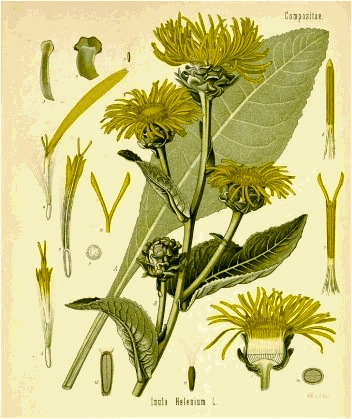
 INULA
(Elecampane)
INULA
(Elecampane)
United States Dispensatory 1926.
Compiled by
Ivor Hughes
INULA. N. F. INULA
[Elecampane]
Inula
consists of the dried rhizome and roots of Inula Helenium Linne (Fam.
Composite). Inula contains not more than 5 per cent, of its stem bases or
more than 2 per cent, other foreign organic matter." N. F.
Elecampane, Aunee, Racine d'Aunee, Oeil de Cheval, Fr; Alantwurzel, G; Enula Campana, It., Sp.
Inula Helenium is a stout, perennial herb naturalized from Europe and growing along roadsides and damp pastures from Nova Scotia to North Carolina and westward as far as Missouri. From a large fleshy, fusiform branching rhizome there arises a stout branching stem which attains a height of about 6 feet and a rosette of radical leaves. The stem leaves are alternate, partly clasping, cordate-oblong, woolly on lower surface with, unequally serrate margins. The flowers occur during summer in golden-yellow heads, each consisting of a naked receptacle bearing yellow, pistillate, ligulate florets along the margin and a central disk of yellow perfect, tubular florets. The exterior of the receptacle is covered by an imbricated involucre, the outer bracts of which are leaf-like. The fruit is a 4-5 ribbed achene. The rhizome and roots should be collected in August of the second year, cut into slices and carefully dried. Since the dried drug is particularly subject to insect attack, it should be preserved in air-tight containers to which a few drops of carbon tetrachloride may be added from time to time as an insecticide. Most of the drug used in the United States is imported from Europe through Rotterdam and Trieste.
Inula has at times been adulterated with stems and foreign roots. Commercial supplies are occasionally mouldy due to carelessness in drying. Most of the imported drug is consumed by proprietary medicine manufacturers.
Description and Physical Properties. � Unground Inula. Rhizome usually split into longitudinal or more or less oblique pieces to which may be attached one or more of the roots; up to 8 cm. long and 4 cm. in diameter; externally grayish brown to dark brown, longitudinally wrinkled with occasional buds or stem scars and surmounted at the crown by a portion of the over-ground stem; inner or cut surface somewhat concave, the edges in-curved with the overlapping bark, yellowish brown to grayish brown, longitudinally striate and more or less fibrous near the cambium zone; fracture short and horny; internally light brown and marked by numerous circular or elliptical oleoresin canals; roots cylindrical and tapering, frequently curved or irregularly curled, up to 13 cm. in length and 1.5 cm. in diameter. Odor aromatic; taste acrid, bitter and pungent.
Structure. � A corky layer of from 4 to 7 rows of broad tabular cells; a cortex of numerous parenchyma cells containing inulin in irregular or fan-shaped masses and a number of large, intercellular secretion cavities containing oleoresin, arranged in nearly radial rows and forming interrupted circles; woody portion consisting chiefly of parenchyma, a number of trachea with simple pores or reticulate thickenings and associated occasionally with a few, strongly lignified wood fibers, and secretion cavities containing oleoresin similar to those occurring in the bark; parenchyma cells in the pith of the rhizome large, containing less inulin than the cells of the wood and bark and separated by large intercellular spaces.
Powdered Inula. � Light brown; consisting chiefly of fragments of parenchyma containing inulin and small, irregular, separated masses of inulin; trachea with simple pores and reticulate thickenings associated occasionally with strongly lignified wood fibers; occasional reddish brown fragments of the walls of the oleoresin canals." N. F.
Constituents. � In 1804 Rose found in this root a peculiar carbohydrate which he called alantin which is now, however, generally known as inulin and which has since been found in many other plants. It differs from starch in that it is not decomposed by boiling water, and gives a yellowish instead of a blue color with iodin. Tanret has also found two related principles that he called pseudo-inulin and inulenin. According to Dragendorff the amount of inulin in the root gathered in the spring is about 19 per cent, but in the fall approaches 45 per cent. When distilled with water elecampane yields from 1 to 2 per cent, of a crystalline substance mixed with volatile oil. The crystalline portion known as alant-camphor appears to be a mixture of alanto-lactone (the anhydride of alantic acid) C15H20O2, and iso-alanto-lactone (helenin) C6H8O. The oily portion which has a peppermint-like odor is composed chiefly of alantol, C10H16O (see Kallen, B. Chem. G., 1873 and 1876).
Korab (L. L., 1885, i, 672) states that helenin is a powerful antiseptic and bactericide, one part in ten thousand being sufficient to kill the ordinary bacteria. He lauds it as antiseptic in surgery and has given it with alleged success internally in doses of one-third to one grain (0.021-0.065 Gm.) in tubercular and catarrhal diarrheas. It is also stated by J. B. Obiol (L. L., April, 1886) to be an efficient local remedy in the treatment of diphtheria. Bockenham (Th. M., 1892, p. 145) asserts that helenin inhibits the growth of tubercle bacilli in the dilution of 1 in 10,000 and it has been employed by various writers in the treatment of pulmonary tuberculosis in doses of from one-sixth to five grains (0.01-0.32 Gm.).
Elecampane is tonic and gently stimulant, and was employed by the ancients in amenorrhea and diseases of women, also in phthisis, in various bronchial catarrhs, and in skin affections, in all of which diseases it was probably of no service.
Dose, twenty grains to one drachm (1.3 - 3.9 Gm.).
Off. Prep.� Pilula Antiperiodica, N. F.; Pilula Antiperiodica sine Aloe, N. F.; Tinctura Antiperiodica, N. F.; Tinctura Antiperiodiea sine Aloe, N.F.
If you did not find what you were seeking, use the site search box at the top right hand of the page or browse the site library and images.
![]()